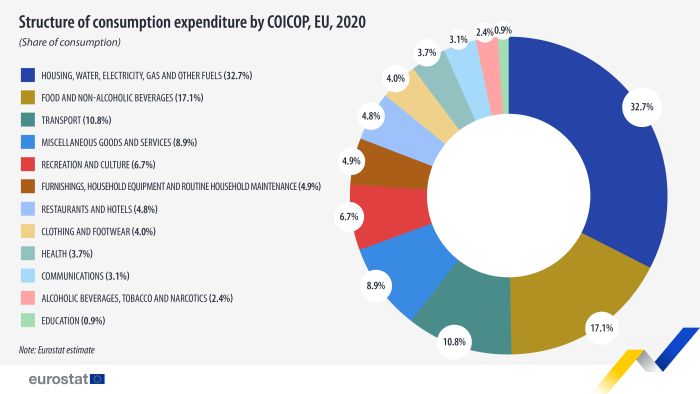Household budget survey - statistics on consumption expenditure
Data extracted in February 2023.
Planned update: September 2024.
Highlights
In 2020, 61% of household consumption expenditure in the EU was spent on housing, food, and transport.
Luxembourg had the highest and Bulgaria the lowest mean consumption expenditure per person in 2020.
In half of the EU Member States, the mean consumption expenditure per person for the 20% of households with the highest incomes was more than double that of the 20% of households with the lowest incomes.
The Household Budget Survey (HBS) is a national survey carried out by EU Member States coordinated ex-post by Eurostat, collecting data primarily on households' consumption expenditure on goods and services. These data are complemented with information on household size and composition, income, and characteristics of the persons living in the households.
This article presents the structure and levels of consumption expenditure in the EU Member States, for the whole population and for different income groups. It is based on the 2020 HBS data collection[1] and compares some of the data with the previous data collection conducted by Eurostat in 2015.
The next update of the article for the reference year 2020 will take place in 2024, when data for the remaining EU Member States will become available.
Full article
Structure of household consumption expenditure
In 2020, 61 % of household consumption expenditure in the EU was spent on housing, food, and transport
Figure 1 shows that, in 2020, more than 60 % of the household consumption expenditure (60.6 %) in 23 EU Member States, for which data are currently available, was spent on the following three (COICOP) consumption categories [2]: Housing, water, electricity, gas and other fuels (32.7 %), Food and non-alcoholic beverages (17.1 %), and Transport (10.8 %). More specifically:
- Expenditure on housing, water, electricity, gas and other fuels represented the highest share of household budgets in the vast majority of EU Member States. This ranged from 8.4 % in Malta to 49.2 % in Hungary.
- The share of household expenditure spent on food and non-alcoholic beverages ranged from 9.4 % in Luxembourg to 27.6 % in Romania. Food and non-alcoholic beverages represented the most important item in household budgets in only two EU Member States, in Estonia (22.3 %) and Malta (19.8 %).
- Household expenditure on transport ranged from 5.2 % in Romania to 18.5 % in Slovenia. This was the second most important item in household budgets in Slovenia (18.5 %), Luxembourg (16.3 %), Denmark (14.3 %), Austria (13.9 %) and Germany (13.5 %).
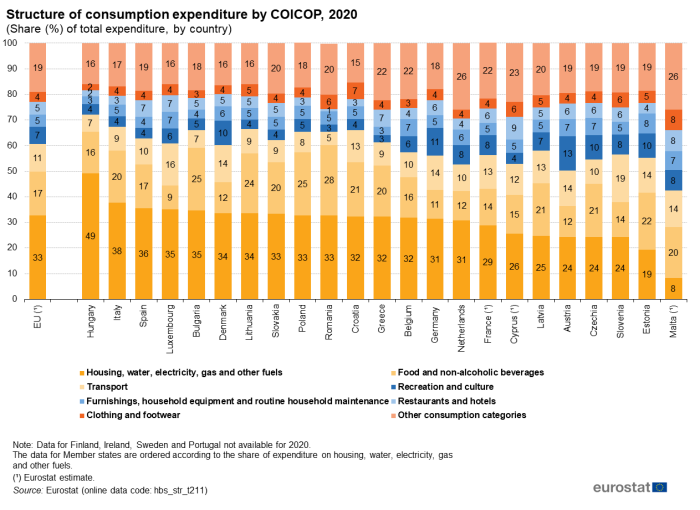
(Share (%) of total consumption expenditure, by country)
Source: Eurostat (hbs_str_t211)
An additional fifth (20.4 %) of household budgets in the EU Member States in 2020 was spent on the following: Recreation and culture (6.7 %), Furnishings and household equipment (4.9 %), Restaurant and hotels (4.8 %) and Clothing and footwear (4.0 %). More detail is provided below:
- Expenditure on recreation and culture was less than 10 % of household budgets in all EU Member States, except for Austria (13.4 %) and Germany (10.8 %). The lowest share was observed in Romania and Greece, both reported 2.8 %.
- EU Member States showed little difference between in the share of expenditure on furnishings, household equipment and routine household maintenance as well as on clothing and footwear. This ranged from 2.9 % in Hungary to 7.7 % in Estonia for the former consumption expenditure category and from 2.4 % in Hungary to 7.9 % in Malta for the latter category.
- On the other hand, major differences among EU Member States were observed for expenditure on restaurants and hotels. The share ranged from 0.9 % in Romania to 8.9 % in Cyprus.
Finally, almost a fifth (19.0 %) of household budgets in the EU Member States in 2020 was spread across the remaining five consumption expenditure categories:
- Health (3.7 %),
- Communications (3.1 %),
- Alcoholic beverages, tobacco and narcotics (2.4 %),
- Education (0.9 %),
- Miscellaneous goods and services, including, for example, personal care, insurance and financial services (8.9 %).
The structure of household consumption expenditure in 2020 was very similar to that observed in 2015 in the EU as a whole. The shares of the different consumption categories varied by less than 1 percentage point (pp) between these two years.
Mean consumption expenditure per person (adult equivalent)
Luxembourg had the highest and Bulgaria the lowest mean consumption expenditure per person in 2020
Map 1 presents the mean consumption expenditure per adult equivalent[3] in Purchasing power standard (PPS) for 2020 for the EU Member States.
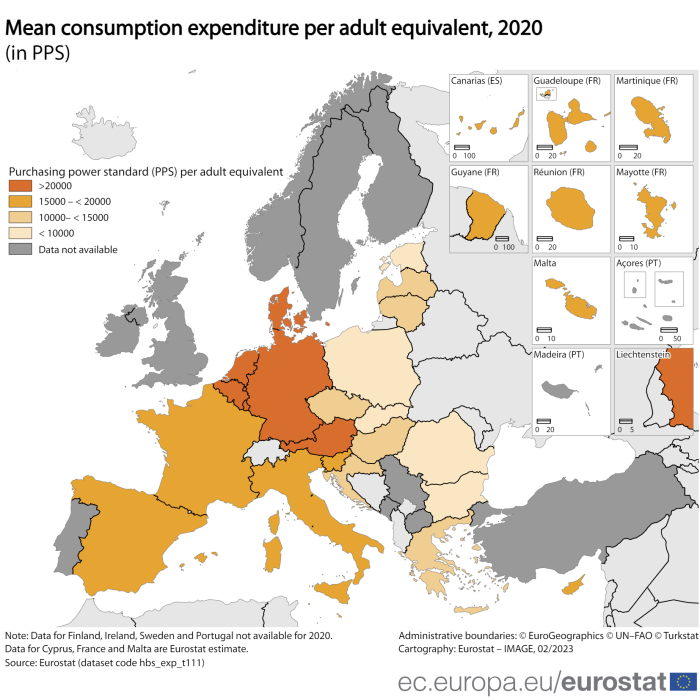
(in PPS)
Source: Eurostat (hbs_exp_t111)
In 2020, the mean consumption expenditure, for the 23 EU Member States that provided the data, was PPS 17 260 per adult equivalent. In 2015 the value was PPS 17 338 for all EU Member States.
The values for 2020 ranged from PPS 8 680 in Bulgaria to PPS 32 755 in Luxembourg. In 2015 Luxembourg also recorded the highest value of mean consumption expenditure (PPS 31 893), while the lowest value in 2015 was recorded in Romania (PPS 6 750).
Comparing 2020 with 2015 data (see Figure 2), the mean consumption expenditure increased in 14 EU Member States out of the 23 for which data are provided. The EU Member States with the largest increases were Hungary and Romania (30 % or more) during the period from 2015 to 2020. The greatest decreases were in Slovakia (-17 %) and Belgium (-11 %).
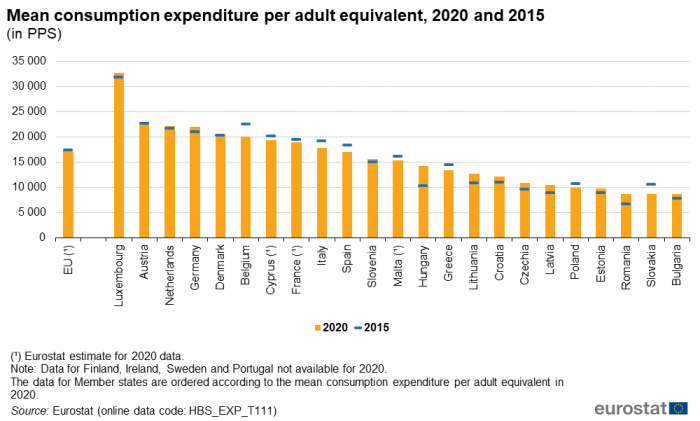
(in PPS)
Source: Eurostat (hbs_exp_t111)
Mean consumption expenditure by income
In half of the EU Member States, the mean consumption expenditure per person for the 20 % of households with the highest incomes was more than double that of the 20 % of households with the lowest incomes
This section presents data on household consumption expenditure per person by levels of household income, using income quintile groups[4].
In Figure 3, the mean consumption expenditure (in PPS per adult equivalent) of the lowest (first) and highest (fifth) income quintile groups are presented, as well as their ratio, which indicates the level of inequalities.
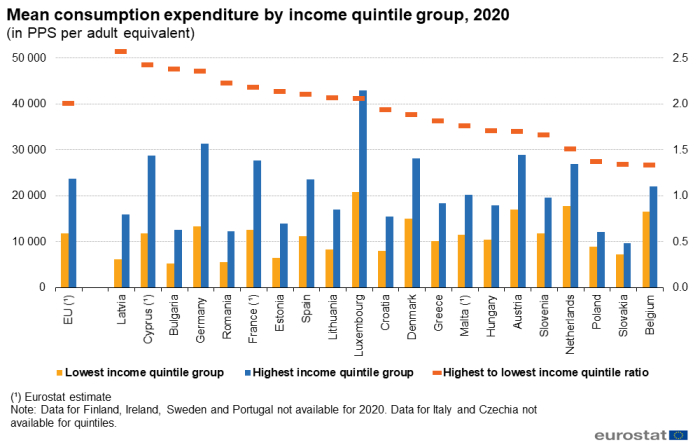
(in PPS per adult equivalent)
Source: Eurostat (hbs_exp_t133)
Out of the 21 EU Member States that provided income data, there were 10 Member States for which the mean consumption expenditure (per adult equivalent) for the households with the highest incomes was more than double that of the households with the lowest incomes. In particular, the highest inequality was recorded in Latvia, where the mean consumption in the highest income quintile group was 2.6 times higher than in the lowest income quintile group. This was also the case in Cyprus, Bulgaria and Germany all with 2.4 ratios. The remaining 11 Member States had ratios lower than 2, with the lowest ratios of 1.4 reported for Poland, and 1.3 for both Belgium and Slovakia.
Source data for tables and graphs
Data sources
The Household Budget Surveys (HBS) are national surveys coordinated at EU level ex-post by Eurostat. The main purpose of HBS is to collect data on households' consumption expenditure on goods and services.
The HBS data are collected via one (or more) interviews and diaries where people register their expenses. The diary in most EU Member States is usually maintained by the households and/or individuals on a daily basis for about 2 weeks. All Household Budget surveys are restricted to the population residing in private households. Collective or institutional households (hospitals, hostels, boarding houses, prisons, etc.) are excluded, as are homeless people. Regarding geographical coverage, most HBS cover the entire population residing in private households in the national territory. However, for reasons of cost and accessibility, some remote areas with very small populations may be excluded.
Expenditure made by households to acquire goods and services is recorded at the price actually paid, which includes indirect taxes (VAT and excise duties) borne by the purchaser. Household consumption expenditure is measured in the national currency, and during processing converted to euro and PPS.
For EU Member States where the data collection period differed from the reference year 2020, household consumption expenditure was adjusted using price coefficients, to bring the price of the data collection period to the level of the reference year. Expenditure data was also adjusted to adult equivalents, in order to increase comparability of data, which can be reduced by differences in the size and demographic structure of households.
The Classification of Individual Consumption by Purpose (COICOP) was developed to classify and analyse individual consumption expenditures incurred by households, according to their purpose. The European Classification of Individual Consumption according to Purpose (ECOICOP) 2013 was used for the 2020 HBS data collection and dissemination of results.
Context
Household budget surveys were launched in most EU Member States at the beginning of the 1960s and Eurostat has been collating and publishing the survey data every five years since 1988; the most recent collection rounds being 2015 and 2020.
The focus of the survey is on consumption expenditure, which is what people spend on goods and services to satisfy their needs and wants. Households are asked to keep records of their expenditures on consumer goods and services over a specified period of time, two weeks being the most common. Measuring consumption expenditure is a way of measuring economic well-being; for a household this can be expressed in terms of its access to goods and services. The more that can be consumed, the higher the level of economic well-being, although the relationship between the two is not linear. HBS data also provides an important input, especially at national level, for weighting the basket of goods and services used to calculate the Consumer Price Index (CPI). The CPI measures the rate of price inflation as experienced and perceived by households in their role as consumers.
As the survey has been conducted until the 2020 wave on a voluntary basis (based on a gentlemen's agreement), some variations are observed among EU Member States in terms of frequency, timing, content or structure.
A note on the possible impact of the COVID-19 pandemic on results: The data collection and expenditure patterns of households in some EU Member States could have been affected by the COVID-19 pandemic and related restrictions. This should be taken into consideration when interpreting the data.
The fieldwork period for the HBS 2020 wave in the EU Member States was as follows: Austria (June 2019–June 2020), Belgium (2020), Bulgaria (April 2019–March 2020), Czechia (2019–2020), Germany (2018), Denmark (2020), Estonia (Dec 2019–Dec 2020), Greece (2020), Spain (2020), Finland (2022), Croatia (2019), Hungary (2019), Ireland (July 2022–June 2023), Italy (2020), Lithuania (May 2021–April 2022), Luxembourg (2020–2021), Latvia (2019), the Netherlands (2020), Poland (2020), Portugal (2022), Romania (2020), Slovenia (2018), Slovakia (2019–2021). For the following EU Member States, data from the HBS 2015 wave were used to compile statistics for the 2020 wave: Cyprus (2015), Malta (2015–2016) and France (2017).
Direct access to
See also
Online publications
- Concepts for household consumption - comparison between micro and macro approach
- Interaction of household income, consumption and wealth - statistics on main results
- Household composition statistics
- Ageing Europe - statistics on pensions, income and expenditure
- Interaction of household income, consumption and wealth - methodological issues
Database
Mean consumption expenditure of private households (hbs_exp)
- Mean consumption expenditure per household and per adult equivalent (hbs_exp_t111)
- Mean consumption expenditure per household by COICOP consumption purpose (hbs_exp_t121)
- Mean consumption expenditure per household with expenditure greater than zero by COICOP consumption purpose (hbs_exp_t123a)
- Households with expenditure greater than zero by COICOP consumption purpose (hbs_exp_t123b)
- Mean consumption expenditure by socio-economic category of the reference person (hbs_exp_t131)
- Mean consumption expenditure by number of active persons (hbs_exp_t132)
- Mean consumption expenditure by income quintile (hbs_exp_t133)
- Mean consumption expenditure by type of household (hbs_exp_t134)
- Mean consumption expenditure by age of the reference person (hbs_exp_t135)
- Mean consumption expenditure by degree of urbanisation (hbs_exp_t136)
- Mean consumption expenditure by main source of the household's income (hbs_exp_t137)
Structure of mean consumption expenditure (hbs_struc)
- Structure of consumption expenditure by COICOP consumption purpose (hbs_str_t211)
- Structure of consumption expenditure by activity and employment status of the reference person and COICOP consumption purpose (hbs_str_t221)
- Structure of consumption expenditure by number of active persons and COICOP consumption purpose (hbs_str_t222)
- Structure of consumption expenditure by income quintile and COICOP consumption purpose (hbs_str_t223)
- Structure of consumption expenditure by type of household and COICOP consumption purpose (hbs_str_t224)
- Structure of consumption expenditure by age of the reference person and COICOP consumption purpose (hbs_str_t225)
- Structure of consumption expenditure by degree of urbanisation and COICOP consumption purpose (hbs_str_t226)
- Structure of consumption expenditure by main source of income and COICOP consumption purpose (hbs_str_t227)
Household characteristics (hbs_carac)
- Household characteristics by activity and employment status of the reference person (hbs_car_t311)
- Household characteristics by number of active persons (hbs_car_t312)
- Household characteristics by type of household (hbs_car_t313)
- Household characteristics by age of the reference person (hbs_car_t314)
- Household characteristics by degree of urbanisation (hbs_car_t315)
- Household characteristics by main source of income (hbs_car_t316)
Dedicated section
Methodology
Legislation
Notes
- ↑ The fieldwork for the 2020 HBS data collection took place between 2018 and 2022 for the majority of the EU Member States. Data for Cyprus, Malta and France were collected between 2015 and 2017. For Finland, Ireland, Portugal and Sweden, data for the 2020 wave were not available when this article was prepared. The data collection and expenditure patterns of households in some EU Member States could have been affected by the COVID-19 pandemic and related restrictions.
- ↑ Consumption categories are defined according to the Classification of Individual Consumption by Purpose (COICOP).
- ↑ The average number of adult equivalents in the household is established by allocating weighting coefficients to the household's members according to their demographic characteristics. The first adult (aged 14 years and over) in the household is assigned a weight of 1, each adult thereafter – a weight of 0.5, and each child a weight of 0.3. Given the existence of large differences in the sizes and structures of households, comparability can be improved by adjusting expenditure for adult equivalent.
- ↑ Households are ordered according to their income and divided into five groups of the same size. Each income quintile group thus represents 20 % of households. This article presents only results for the first and fifth income quintile group, that is 20 % of households with the lowest incomes and the 20 % of households with the highest incomes.
